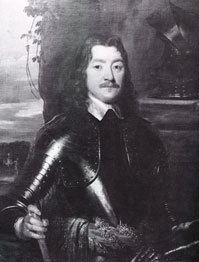Allegiance Royalist Service/branch Cavalry officer | Name Charles Lucas | |
 | ||
Buried at St. Giles's Church, Colchester (now St. Giles Masonic Centre) (51°53′10.5″N 0°54′8.42″E / 51.886250°N 0.9023389°E / 51.886250; 0.9023389Coordinates: 51°53′10.5″N 0°54′8.42″E / 51.886250°N 0.9023389°E / 51.886250; 0.9023389) Rank Lieutenant General of Horse Siblings Margaret Cavendish, Duchess of Newcastle-upon-Tyne Similar People George Lisle, Thomas Fairfax, Margaret Cavendish - Duchess, William Cavendish - 1st Duke, Arthur Capell - 1st Baron Ca | ||
Mvi 1294 candidate for office of mayor ec mr charles lucas
Sir Charles Lucas (1613 – 28 August 1648) was an English soldier, a Royalist commander in the English Civil War.
Contents
- Mvi 1294 candidate for office of mayor ec mr charles lucas
- BUGSY MALONE SIR CHARLES LUCAS SCHOOL 1984 PART 1
- Origins
- Career
- Execution burial
- Contemporary reputation
- Obelisk
- Literary
- Portraits
- References
BUGSY MALONE - SIR CHARLES LUCAS SCHOOL 1984 - PART 1
Origins
Lucas was a younger son of Sir Thomas Lucas (d. 1625) of Colchester in Essex, by his wife Elizabeth Leighton, daughter of John Leighton of London, gentleman. His elder brothers Sir John Lucas (d.1671) (in 1645 created Baron Lucas) and Sir Thomas Lucas (d. 1649) fought for the King. His younger sister Margaret Lucas, later Duchess of Newcastle, described her brother's youthful career in her autobiography.
Career
As a young man Lucas served as a soldier in the Netherlands under the command of his brother, and in the "Bishops' Wars" he commanded a troop of horses in the army of King Charles I. In 1639 he was knighted. At the outbreak of the Civil War, Lucas naturally took the king's side, and was wounded at the Battle of Powick Bridge, the first cavalry engagement.
Early in 1643 Lucas raised a regiment of horse, with which he defeated Middleton at Padbury on 1 July. In January 1645 he commanded the forces attacking Nottingham, and soon afterwards, on the recommendation of Prince Rupert, he was made lieutenant-general of the Duke of Newcastle's Northern army. When Newcastle was shut up in York, Lucas and the cavalry remained in the open country, and when Rupert's relieving army crossed the hills into Yorkshire he was quickly joined by Newcastle's squadrons.
At the Battle of Marston Moor Lucas swept Fairfax's Yorkshire horse before him, but later in the day he was taken prisoner, in a battle won decisively by Parliament. Exchanged for Parliamentary prisoners during the winter, he defended Berkeley Castle, in Gloucestershire, for a short time against Thomas Rainsborough, but was soon back in the field. As lieutenant-general of all the horse, he accompanied Lord Astley in the last campaign of the first war, and taken prisoner again at Stow-on-the-Wold, he agreed not to bear arms against Parliament in the future.
During the Second Civil War he broke this parole when he took a prominent part in the seizure of Colchester in 1648. Following the three-month Siege of Colchester, the town surrendered to Fairfax on 28 August 1648.
Execution & burial
When Colchester capitulated the superior officers were obliged to "render themselves to mercy", and Lucas was condemned to death by a court martial. The sentence was the result of the exasperation felt by the puritan officers against the authors of the second civil war, but can neither be regarded as a breach of the capitulation, nor be specially attributed to Fairfax. Parliament by its votes of 20 June 1648 had declared all who took part in the new civil war guilty of high treason, and Henry Ireton used this argument to justify the sentence. "I am no traitor," answered Lucas, "but a true subject to my king and the laws of the kingdom ... I do plead before you all the laws of this kingdom. I have fought with a commission from those that were my sovereigns, and from that commission I must justify my action". Lucas and his fellow-prisoner, Sir George Lisle, were shot to death on 28 August 1648 in the castle yard at Colchester, and were buried in the vault of the Lucas family in the north aisle of St. Giles's Church, Colchester.
Twelve years later, on 7 June 1661, the funeral of Lucas and Lisle was solemnly celebrated by the town of Colchester, and a stone was placed by John Lucas, 1st Baron Lucas on their tombs, with an inscription stating that they were "by the command of Sir Thomas Fairfax in cold blood barbarously murdered". By way of reparation, Lucas was awarded a posthumous peerage in 1666.
Contemporary reputation
Lucas was reputed to be one of the best cavalry leaders in the king's army. Even Clarendon, who judges him with undue severity, describes him as "very brave in his person, and in a day of battle a gallant man to look upon and follow". According to his sister, Lucas "naturally had a practical genius to the warlike arts, as natural poets have to poetry, but his life was cut off before he could arrive at the true perfection thereof". He left a Treatise of the Arts of War, but being written in cipher it was never published. To his military gifts Lucas added a devotion to the king's cause, which he sometimes expressed in singularly high-flown and poetical language.
Obelisk
An inscribed stone obelisk in commemoration of Lucas and Lisle exists at Colchester Castle.
Literary
Lucas and Lisle are celebrated in two contemporary poems:
Portraits
A portrait of Lucas, by Robert Walker, was in the possession of Lord Lyttelton in 1900. Engraved portraits are in Warburton's Prince Rupert and in the illustrated edition of Clarendon's Rebellion, said to be after a painting by William Dobson.
